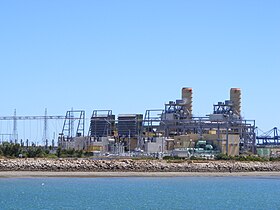Pelican Point Power Station
| Pelican Point Power Station | |
|---|---|
 |
|
| Country | Australia |
| Location | Pelican Point, South Australia |
| Coordinates | 34°45′47″S 138°30′18″E / 34.76306°S 138.50500°ECoordinates: 34°45′47″S 138°30′18″E / 34.76306°S 138.50500°E |
| Commission date | 2001 |
| Owner(s) | GDF Suez Australian Energy |
| Thermal power station | |
| Primary fuel | Natural gas |
| Type | CCGT |
| Cooling source | Sea |
| Power generation | |
| Units operational | Half capacity: one gas and one steam turbine |
| Nameplate capacity | 485 MW |
The Pelican Point Power Station is located at Pelican Point, 20 km from the centre of Adelaide, South Australia on the Lefevre Peninsula. It is operated by GDF Suez Australian Energy, a subsidiary of Engie, which owns 72 per cent of the power station. Mitsui owns the remaining 28 per cent. It burns natural gas in a combined cycle power station, comprising two 160 MW gas turbines and one 165 MW steam turbine, to generate up to 485 MW of electricity.
Construction began in 1999. The plant has two GT13E2 gas turbines manufactured by ABB (now Alstom). The plant, including steam turbine and heat recovery steam generator (HRSG), was manufactured and constructed by ABB.
Fuel is supplied via either the SEAGas pipeline, which runs from the Iona gas plant in Victoria to the Pelican Point power station, or the Moomba Adelaide Pipeline System (MAPS), which supplies gas from Moomba to Adelaide.
Since March 2013 the power station has generally operated at half capacity due to over-capacity in the South Australian region of the National Electricity Market. Grid generation capacity was reduced in early 2016 when the Northern Power Station closed. Generation at Pelican Point was increased to full capacity at the request of the South Australian government for at least a week in July 2016, due to much of the state's wind generation being offline due to damaging high winds, and the Heywood interconnector being unavailable due to works associated with a planned increase in its capacity. It returned to only operating one unit (half capacity) and the owner claimed that the National Electricity Market rules prohibited the second unit from responding to a request for electricity market responses on 8 February 2017. The result was that the extremely hot weather in Adelaide plus little wind to drive wind turbines led to the market operator requiring "load shedding" for 27 minutes during the evening electricity demand peak. The owner later clarified that it is not allowed to bid into the market if supply cannot be guaranteed, and it did not have a current gas supply contract for the second unit. It was able to respond promptly once directed to do so on 9 February during continuing high temperature weather.
...
Wikipedia

